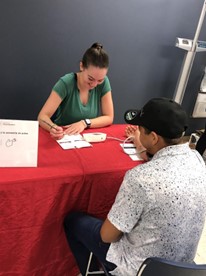Blood Pressure and Pulse Oximetry Station
Stations
- Height and Weight
- Blood Pressure and Pulse Oximetry
- Blood Glucose and Cholesterol Testing
- Eye Glasses
- Healthy Mother & Healthy Baby
- Dental Program
- Physical & Occupational Therapy
- Cardiac, Cancer, and Rheumatology Screenings
- Opioid Resource Distribution
- Medical Residents
- Mental Health & Wellness
- Wound Care
Blood Pressure and Pulse Oximetry Station: Monitoring Your Cardiovascular Health
Step into the realm of cardiovascular well-being, where our Blood Pressure and Pulse Oximetry Station awaits to safeguard your heart health. Here’s a detailed insight into the process:
1. Preparation for Accuracy:
The patient is asked to remove any jackets or roll long sleeves up. Screens are available for patients to go behind if they need to take their arm out of their top.
2. Proper Seating Position:
The patient is directed to sit with their feet flat on the floor, their back against the chair, and their arm resting on the table, palm up.
3.Cuff Placement and Adjustment:
The cuff is placed on the arm, about 1 inch above the elbow. The cuff is evenly tight and can fit two fingers between the cuff and the arm. The cuff is positioned so that the sensor is over the center of the arm.
4. Blood Pressure Measurement:
When the automatic cuff is activated, the cuff inflates until the systolic blood pressure is measured and deflates until the diastolic blood pressure is measured.
5. Pulse Oximetry:
A pulse oximeter clip is placed on the patient’s finger to measure oxygen saturation and heart rate.




